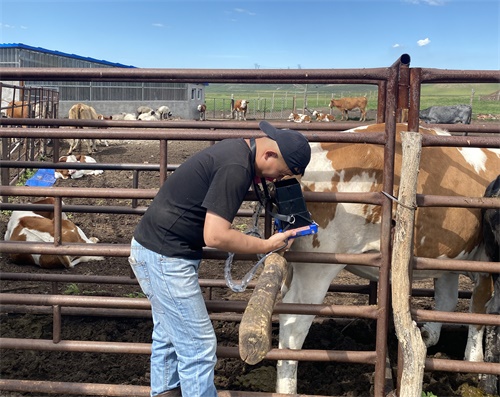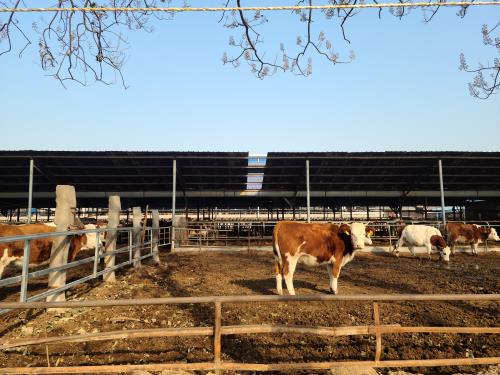Bovine respiratory disease (BRD) is one of the main health issues affecting dairy calves. There are many consequences of this disease, which may have a significant impact on the future lives of these calves in the herd. Disease recurrence, mortality rate, decreased growth rate, and transmission of infectious factors, to name a few, are potential consequences of BRD affecting young dairy substitute subjects. In addition, besides these consequences, we must also include the cost of antibiotic treatment and additional labor costs. Research has shown that compared to healthy calves of the same age as the control group, dairy calves treated for respiratory diseases before three months of age died more frequently than those at three months of age. Nevertheless, we can be certain that it is important to find a method for detecting BRD as early as possible, including subclinical forms of the disease. Although it is easy to overlook in routine animal examinations, there are significant economic impacts related to subclinical forms.
In order to identify clinical cases of BRD, clinical symptoms such as high body temperature, anorexia, drowsiness, abnormal respiratory noise, shortness of breath, and difficulty breathing are important. Various scoring systems can be used to assess the clinical symptoms of individual calves for the diagnosis of BRD. These scoring systems can help producers identify sick calves and establish treatment based on veterinary protocols. However, determining the subclinical form of BRD or chronic lung disease is much more difficult. However, even more difficult rhythm is impossible! Breast ultrasound examination (TUS) for imported cattle is an excellent tool for identifying subclinical or chronic lesions.
Why choose imported cattle for B-ultrasound examination?
Firstly, it has been demonstrated that the B-ultrasound images of imported cows are highly correlated with the radiographic images and autopsy lesions observed in dairy calves. A study evaluating the use of B-ultrasound examination as a diagnostic test for BRD in imported cattle, in which the BRD status was confirmed through autopsy, reporting a sensitivity of 86% to 94% and a specificity of 98% to 100%. Another study reported that the sensitivity and specificity of using only lung auscultation for diagnosing bronchopneumonia (BP) in dairy cows were only 72.9% and 53.3%, respectively. The accuracy of blood pressure detection is significantly increased when ultrasound examination of imported cattle is added to thoracoscopy. Therefore, B-ultrasound examination of imported cattle is a very good non-invasive method for identifying pre death lung lesions in calves.
Secondly, there are other advantages to using B-ultrasound examination for imported cattle, which makes this technique very meaningful for the diagnosis of subclinical BRD. Imported cattle B-ultrasound has been widely used for early pregnancy diagnosis, so a large number of dairy industry practitioners already have portable imported cattle B-ultrasound waves with 8.5MHz linear probes. This same device can be used for chest ultrasound examination of imported cattle, avoiding the need to purchase additional equipment. During the B-ultrasound examination of imported cattle, it is not necessary to shave the chest cavity. In addition, each practitioner can easily obtain 70% isopropanol, which can be used as a medium for imported Cattle Ultrasound wave transmission to obtain high-quality images. In order to complete the scan, it is important to know the anatomical structure of the bovine lung and the external landmarks that can be recognized on the calf. The scanning must be systematic, scanning all lengths of each rib gap from top to bottom, and thoroughly scanning each side. The left lung extends from the second to 10 intercostal spaces, while the right lung extends from * * * to the tenth intercostal space. Lung lesions can be recorded according to different scoring systems (some are more complete than others). The use of imported cattle for lung examination with B-ultrasound waves is fast, with each calf changing between 30 seconds and 5 minutes, depending on the experience of the person using the technology and scoring system for the imported cattle examination with B-ultrasound waves.
In addition to being a fast technology, it is also a very simple technology with low related costs, which has been well described in the literature*** Recently, a study evaluated the results obtained from B-ultrasound examination of imported cattle from the chest and user experience. The reserved conclusion is that the lung consolidation lesions evaluated by imported cattle using B-ultrasound have good to excellent intra group correlation coefficients, and the results are comparable among users regardless of their experience.
In short, B-ultrasound examination for imported cattle has a place in our actual farm, which can help diagnose lung diseases on site for breast and calf diseases, and even novice imported cattle B-ultrasound operators can consistently perform it through appropriate training.
Imported cattle using B-ultrasound
The benefits of using ultrasound to identify diseased individuals in imported cattle
Respiratory diseases are the main problem for dairy calves, mainly because the signs of calves are not always obvious. As mentioned earlier, respiratory diseases are associated with higher production costs, higher mortality and recurrence risks, as well as reduced growth rates and early rejection for dairy calves*** A recent study has shown that subclinical BRD diagnosed by B-ultrasound examination in dairy calves undergoing systematic chest import is associated with a significant decrease in growth rate in later heifers. It has been proven that calves with severe lung disease have a significantly reduced chance of survival during the * * * lactation period*** Recently, another study concluded that there is at least one lung consolidation area (≥ 3cm),
In addition, compared to cows with lung consolidation (52.5%), heifers without lung consolidation had a higher conception rate (62.0%) after artificial insemination. Imported cattle ultrasound waves are an objective tool for diagnosing BRD (regardless of the presence of lesions), which can be easily applied/integrated into farm screening examinations within a fixed time period to target specific individuals or groups at risk. Poor performance or being eliminated. Professionals who can use this tool can accurately identify potential non productive animals in the first few months of life. This will allow for a choice between two options*** Early removal of animals will help reduce wasted feed days, decrease funding for future pneumonia treatment, and improve overall profitability and animal welfare of the livestock population. Alternatively, animals with a good genetic background can be preserved, with the understanding that they may never reach their full genomic potential. Producers can also apply specific treatment plans or tools to help young affected calves heal.
In short, it must be remembered that with appropriate technology and portable imported B-ultrasound waves, cattle practitioners can already use them for reproductive examinations, which can quickly scan and evaluate the lung condition of lactating calves. This program is very precise and accurate, and can also retrieve information related to lung lesions associated with BRD in dairy calves. On an individual basis, B-ultrasound examination of imported cattle can help identify negative prognostic risk factors, which can assist producers in making early decisions for exclusion. At the herd level, the use of B-ultrasound waves in imported cattle can help identify animal populations at risk of respiratory diseases (with BRD being the main focus), in order to monitor the prevalence and severity of lesions at any time. In addition, management changes such as vaccination, ventilation, and any labor force changes can be evaluated. Breast ultrasound examination of imported cattle can be seen as an added value to the services provided by veterinarians and provides an opportunity to improve animal health. This service can also provide veterinarians with additional opportunities to establish trust relationships with producers. In the long run, this may allow for easier solutions when it comes to addressing other issues found on farms or aspects that contribute to improving producer profitability and/or herd welfare. This service can also provide veterinarians with additional opportunities to establish trust relationships with producers. In the long run, this may allow for easier solutions when it comes to addressing other issues found on farms or aspects that contribute to improving producer profitability and/or herd welfare. This service can also provide veterinarians with additional opportunities to establish trust relationships with producers. In the long run, this may allow for easier solutions when it comes to addressing other issues found on farms or aspects that contribute to improving producer profitability and/or herd welfare.
Occasionally, lung lesions may seem like a minor issue and do not seem to have a negative impact on calves, but what do we know from research now? The reward is inversely proportional







